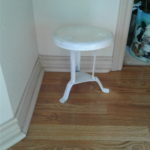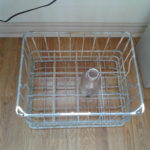
Roger Williams
Carroll Williams
The Williams Dairy began in Necessity, Texas, a community in Southeast Stephens County. My Dad, Rankin Williams, was a farmer who began milking some cows. He sold the milk in Breckenridge.
My brother, Carrolll . was involved from an early age. Carroll was driving before he could reach the pedals on the floor of the vehicle. He stood to drive. The neighbors watched in amusement every morning as he drove by before school taking the cans of milk a short distance to a neighbor, Sam Taylor, who took the milk on into Breckenridge.
In the early 1930s, the dairy was moved east of Breckenridge to a location on Highway 180. The cows were herded to the new location. They were milked in Necessity in the morning and in Breckenridge in the evening. Carroll moved the bull later in their stock trailer. He looked in the rearview mirror and realized the bull was running. He stopped. The bull had stepped through some rotten boards in the bottom of the trailer and was trying to keep up with the pickup.


- The only location I remember was one mile south of Breckenridge on the west side of US Highway 183. By this time, the milk was being retailed. Milk was delivered to homes, grocery stores, and cafes. Milk was often taken inside a home and put inside the icebox or refrigerator. Frequently this was before the family had begun their day.
Working with the milk was a family affair. I watched as the milk was processed. As soon as I was old enough, I helped. Putting empty milk bottles on the bottling machine and putting filled ones into cases was probably my first helpful task Eventually, I could fill the bottles, cap them, and put them into the cases. Our little machine filled two quarts at a time.
My regular job became washing the glass bottles. In elementary school, I got off the school bus, went to the milk house, counted the number of cases of dirty bottles, and estimated how long it would take to wash them. I then changed clothes and began my job.
The bottles were washed one at a time on a brush rotated by an electric motor. They went from the wash into the water with disinfectant. I called it the “BK” rinse. The “bacteria killer” was a powder that came in a barrel. Last was a clear water rinse. The bottles were turned upside down in the cases to drain and dry. The cases were on rolling dollies. The milk house cement floor was slightly slanted toward floor drains. Dry bottles went into another room where they were filled. The third room contained a heavily insulated cold storage vault. The milk was stored there until it was delivered.

When I started junior high, I was replaced by an automatic bottle washing machine. It was a monster, and the room had to be enlarged. Two neighbor boys were hired to operate it. I liked to joke that it took two to replace me. I didn’t add that they had other jobs also.

Some milk customers paid by putting coins inside the empty bottles. Others paid monthly. (Some never paid at all.) I separated the coins and rolled them in the paper provided by the bank. I got the pennies. One of the customers owned a jewelry store. In 5th grade, I had enough money to buy a Bulova watch from Edwards Jewelry Store. I wore that watch until I married, and Ken bought me a new one. I still have the watch.
I had my own customer. A local business owner lived in the Burch Hotel and only got milk once a week. I would go on the route with Dad, ride the elevator up to their apartment, take the milk in, and put it in their refrigerator. There was one problem. They never paid their bill.
When the milk began to be pasteurized, customers didn’t like the “cooked” taste, so only a portion was pasteurized. Gradually, it was all pasteurized. Then customers didn’t like homogenized milk because there was no cream on the top. Eventually, it was all pasteurized, homogenized milk.
The cows were tested and the dairy inspected on a regular basis to maintain its Grade A rating.
I have fond memories of the dairy employees. Dad’s cousin, Finis Williams, was a delivery man. His wife, Gladys, worked in the milk house for several years. Carroll’s father-in-law, Albert Linam, milked the cows for many years. His mother-in-law, Emma Linam, worked in the milk house for a short time.
In the late fifties, the dairy was sold to Boswell Dairy of Fort Worth. They really just bought the customer list. The equipment was too small for their operation.
My dad did not make an issue of customers not paying their bills. The route books contained $40,000 plus in unpaid bills when the dairy was sold. My brother and Dad could certainly have used that money.



Related Posts (posts are in chronological order)
“The Dairy Barn” 10-21-17
“Thankful for Spotted Cows” 11-25-14
“A Good Man” 1-15-15″
“Pennies Bought a Watch” 8-22-14
“Glass Milk Bottles” 8-22-14